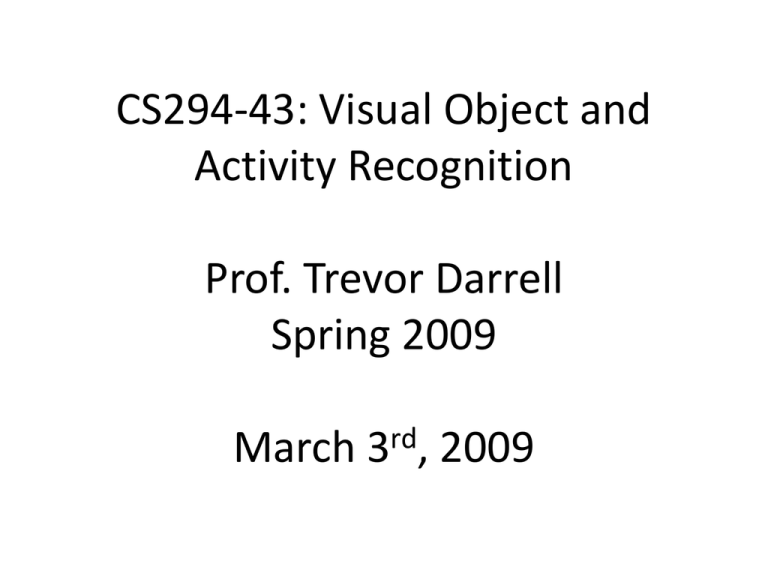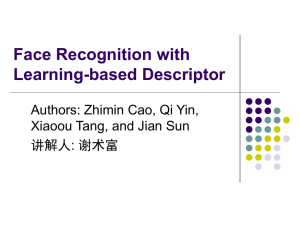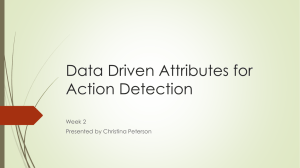Discriminative Metho..
advertisement

CS294‐43: Visual Object and
Activity Recognition
Prof. Trevor Darrell
Spring 2009
March 3rd, 2009
Last Week– Voting, Hashing, and Random
Forest techniques
•
B. Leibe, A. Leonardis, and B. Schiele, "An implicit shape model for combined object
categorization and segmentation," In ECCV workshop on statistical learning in
computer vision 2006, pp. 508-524.
•
A. Frome, Y. Singer, F. Sha, and J. Malik, "Learning globally-consistent local distance
functions for shape-based image retrieval and classification," in Proceedings of IEEE
11th International Conference on Computer Vision, 2007, pp. 1-8.
•
J. Shotton, M. Johnson, and R. Cipolla, "Semantic texton forests for image
categorization and segmentation," in Computer Vision and Pattern Recognition, 2008.
CVPR 2008. IEEE Conference on, 2008, pp. 1-8.
•
P. Jain, B. Kulis, and K. Grauman, "Fast image search for learned metrics," in
Proceedings of IEEE Conference on Computer Vision and Pattern Recognition, 2008,
pp. 1-8
•
M. Ozuysal, P. Fua, and V. Lepetit, "Fast keypoint recognition in ten lines of code," in
Computer Vision and Pattern Recognition, 2007. CVPR '07. IEEE Conference on,
2007, pp. 1-8.
•
A. Torralba, R. Fergus, and Y. Weiss, "Small codes and large image databases for
recognition," in Computer Vision and Pattern Recognition, 2008. CVPR 2008. IEEE
Conference on, 2008, pp. 1-8.
Today – (More) Discriminative approaches
(SVM, HCRF)
• Classic SVM on “bags of features”:
C. Dance, J. Willamowski, L. Fan, C. Bray, and G. Csurka, "Visual categorization with bags of
keypoints," in ECCV International Workshop on Statistical Learning in Computer Vision,
2004.
• ISM + SVM + Local Kernels:
M. Fritz; B. Leibe; B. Caputo; B. Schiele: Integrating Representative and Discriminant Models
for Object Category Detection, ICCV'05, Beijing, China, 2005 [M. Fritz]
• Local SVM:
H. Zhang, A. C. Berg, M. Maire, and J. Malik, "Svm-knn: Discriminative nearest neighbor
classification for visual category recognition," in CVPR '06: Proceedings of the 2006 IEEE
Computer Society Conference on Computer Vision and Pattern Recognition. Washington,
DC, USA: IEEE Computer Society, 2006, pp. 2126-2136. [M. Maire]
• “Latent” SVM with deformable parts:
P. Felzenszwalb, D. Mcallester, and D. Ramanan, "A discriminatively trained, multiscale,
deformable part model," in IEEE International Conference on Computer Vision and Pattern
Recognition (CVPR) Anchorage, Alaska, June 2008., June 2008.
• Hidden Conditional Random Fields:
Y. Wang and G. Mori, “Learning a Discriminative Hidden Part Model for Human Action
Recognition”, Advances in Neural Information Processing Systems (NIPS), 2008
But first…
Some hints from Subransu Maji’s latest work
on discriminative voting….
Generative vs. Discriminative
“Model the world”
“Model the decision”
Today – Discriminative approaches
•
C. Dance, J. Willamowski, L. Fan, C. Bray, and G. Csurka, "Visual
categorization with bags of keypoints," in ECCV International Workshop on
Statistical Learning in Computer Vision, 2004.
•
M. Fritz; B. Leibe; B. Caputo; B. Schiele: Integrating Representative and Discriminant
Models for Object Category Detection, ICCV'05, Beijing, China, 2005
•
H. Zhang, A. C. Berg, M. Maire, and J. Malik, "Svm-knn: Discriminative nearest
neighbor classification for visual category recognition," in CVPR '06: Proceedings of
the 2006 IEEE Computer Society Conference on Computer Vision and Pattern
Recognition. Washington, DC, USA: IEEE Computer Society, 2006, pp. 2126-2136.
•
P. Felzenszwalb, D. Mcallester, and D. Ramanan, "A discriminatively trained,
multiscale, deformable part model," in IEEE International Conference on Computer
Vision and Pattern Recognition (CVPR) Anchorage, Alaska, June 2008., June 2008.
•
Y. Wang and G. Mori, “Learning a Discriminative Hidden Part Model for Human
Action Recognition”, Advances in Neural Information Processing Systems (NIPS),
2008
Basic recognition flow
…
…
…
Index each one into pool
of descriptors from
previously seen images
or
Describe
features
List of positions,
scales,
orientations
Associated list of
d-dimensional
descriptors
or
Quantize to form
bag of words vector
for the image
Compute match
with another image
(Next Lexture)
K. Grauman, B. Leibe
…
Detect or sample
features
Dance et al.
…
…
Describe
features
List of positions,
scales,
orientations
Associated list of
d-dimensional
descriptors
Quantize to form
bag of words vector
for the image
SVM
…
Detect or sample
features
SVM Review…
Separable by a hyperplane in 2-d:
x2
x1
Which one?
x2
x1
Maximum Margin:
x2
x1
Linear SVM Classifier
Data: {xi , yi} i =1,2,3 … N yi = {-1,+1}
Discriminant: f(x) = (w . x + b) > 0
minimize || w ||
subject to yi (w . xi + b) > 1
Solution: QP gives {ai}
wopt = S ai yi xi
f(x) = S ai yi (xi . x) + b
for all i
Non-separable by a hyperplane in 2-d
x2
x1
Non-separable by a hyperplane in 2-d
x2
x1
Separable by a hyperplane in 3-d
x2
x1
x22
Embedding
Learning with Kernels, Scholkopf and Smola, 2002
Kernels
• linear classifier:
• Kernel classifier:
[Dance et al.]
Learning with Kernels, Scholkopf and Smola, 2002
Example Kernel functions
•
•
•
•
•
Polynomials
Gaussians
Sigmoids
Radial basis functions
Local feature Kernels (c.f. Fritz et al. and
correspondence Kernels in next lecture)
Tried linear, quadratic, cubic; linear had best performance….
K(
,
) = K(
,
)=<
,
>
[Dance et al.]
SVM:
Naïve
Bayes:
[Dance et al.]
Today – Discriminative approaches
•
C. Dance, J. Willamowski, L. Fan, C. Bray, and G. Csurka, "Visual categorization with
bags of keypoints," in ECCV International Workshop on Statistical Learning in
Computer Vision, 2004.
•
M. Fritz; B. Leibe; B. Caputo; B. Schiele: Integrating Representative and
Discriminant Models for Object Category Detection, ICCV'05, Beijing, China,
2005
•
H. Zhang, A. C. Berg, M. Maire, and J. Malik, "Svm-knn: Discriminative nearest
neighbor classification for visual category recognition," in CVPR '06: Proceedings of
the 2006 IEEE Computer Society Conference on Computer Vision and Pattern
Recognition. Washington, DC, USA: IEEE Computer Society, 2006, pp. 2126-2136.
•
P. Felzenszwalb, D. Mcallester, and D. Ramanan, "A discriminatively trained,
multiscale, deformable part model," in IEEE International Conference on Computer
Vision and Pattern Recognition (CVPR) Anchorage, Alaska, June 2008., June 2008.
•
Y. Wang and G. Mori, “Learning a Discriminative Hidden Part Model for Human
Action Recognition”, Advances in Neural Information Processing Systems (NIPS),
2008
Today – Discriminative approaches
•
C. Dance, J. Willamowski, L. Fan, C. Bray, and G. Csurka, "Visual categorization with
bags of keypoints," in ECCV International Workshop on Statistical Learning in
Computer Vision, 2004.
•
M. Fritz; B. Leibe; B. Caputo; B. Schiele: Integrating Representative and Discriminant
Models for Object Category Detection, ICCV'05, Beijing, China, 2005
•
H. Zhang, A. C. Berg, M. Maire, and J. Malik, "Svm-knn: Discriminative nearest
neighbor classification for visual category recognition," in CVPR '06:
Proceedings of the 2006 IEEE Computer Society Conference on Computer
Vision and Pattern Recognition. Washington, DC, USA: IEEE Computer
Society, 2006, pp. 2126-2136.
•
P. Felzenszwalb, D. Mcallester, and D. Ramanan, "A discriminatively trained,
multiscale, deformable part model," in IEEE International Conference on Computer
Vision and Pattern Recognition (CVPR) Anchorage, Alaska, June 2008., June 2008.
•
Y. Wang and G. Mori, “Learning a Discriminative Hidden Part Model for Human
Action Recognition”, Advances in Neural Information Processing Systems (NIPS),
2008
Today – Discriminative approaches
•
C. Dance, J. Willamowski, L. Fan, C. Bray, and G. Csurka, "Visual categorization with
bags of keypoints," in ECCV International Workshop on Statistical Learning in
Computer Vision, 2004.
•
M. Fritz; B. Leibe; B. Caputo; B. Schiele: Integrating Representative and Discriminant
Models for Object Category Detection, ICCV'05, Beijing, China, 2005
•
H. Zhang, A. C. Berg, M. Maire, and J. Malik, "Svm-knn: Discriminative nearest
neighbor classification for visual category recognition," in CVPR '06: Proceedings of
the 2006 IEEE Computer Society Conference on Computer Vision and Pattern
Recognition. Washington, DC, USA: IEEE Computer Society, 2006, pp. 2126-2136.
•
P. Felzenszwalb, D. Mcallester, and D. Ramanan, "A discriminatively trained,
multiscale, deformable part model," in IEEE International Conference on
Computer Vision and Pattern Recognition (CVPR) Anchorage, Alaska, June
2008., June 2008.
•
Y. Wang and G. Mori, “Learning a Discriminative Hidden Part Model for Human
Action Recognition”, Advances in Neural Information Processing Systems (NIPS),
2008
Discriminatively Trained
Mixtures of Deformable Part
Models
Pedro Felzenszwalb and Ross Girshick
University of Chicago
David McAllester
Toyota Technological Institute at
Chicago
Deva Ramanan
UC Irvine
http://www.cs.uchicago.edu/~pff/latent
PASCAL Challenge
• ~10,000 images, with ~25,000 target objects.
- Objects from 20 categories (person, car, bicycle, cow,
table...).
- Objects are annotated with labeled bounding boxes.
Model Overview
•
•
•
Mixture of deformable part models (pictorial structures)
Each component has global template + deformable parts
Fully trained from bounding boxes alone
2 component bicycle model
root filters
part filters
coarse resolution finer resolution
deformation
models
Object Hypothesis
Score of filter is dot
product of filter with HOG
features underneath it
Score of object hypothesis
is sum of filter scores
minus deformation costs
Multiscale model captures features at two resolutions
Model
Latent SVM
Linear in w if z is fixed
Regularization
Hinge loss
Latent SVM training
•
•
•
•
Non-convex optimization
Huge number of negative examples
Convex if we fix z for positive examples
Optimization:
-
Initialize w and iterate:
-
Pick best z for each positive example
Optimize w via gradient descent with data mining
•
•
•
Initializing w
For k component mixture model:
Split examples into k sets based on bounding box aspect
ratio
Learn k root filters using standard SVM
-
•
Training data: warped positive examples and random
windows from negative images (Dalal & Triggs)
Initialize parts by selecting patches from root filters
-
Subwindows with strong coefficients
Interpolate to get higher resolution filters
Initialize spatial model using fixed spring constants
Car model
root filters
part filters
coarse resolution finer resolution
deformation
models
Person model
root filters
part filters
coarse resolution finer resolution
deformation
models
Bottle model
root filters
part filters
coarse resolution finer resolution
deformation
models
Histogram of Gradient (HOG) features
•
•
Dalal & Triggs:
-
•
Normalize with respect to 4 different neighborhoods and truncate
9 orientations * 4 normalizations = 36 features per block
PCA gives ~10 features that capture all information
•
Histogram gradient orientations in 8x8 pixel blocks (9 bins)
Fewer parameters, speeds up convolution, but costly projection at
runtime
Analytic projection: spans PCA subspace and easy to compute
-
9 orientations + 4 normalizations = 13 features
We also use 2*9 contrast sensitive features for 31 features total
Bounding box prediction
•
•
(x1, y1)
(x2, y2)
predict (x1, y1) and (x2, y2) from part locations
linear function trained using least-squares
regression
Context rescoring
•
•
•
•
•
•
Rescore a detection using “context” defined by all
detections
Let vi be the max score of detector for class i in the image
Let s be the score of a particular detection
Let (x1,y1), (x2,y2) be normalized bounding box coordinates
f = (s, x1, y1, x2, y2, v1, v2... , v20)
Train class specific classifier
-
f is positive example if true positive detection
f is negative example if false positive detection
Bicycle detection
More bicycles
False positives
Car
Person
Bottle
Horse
Code
Source code for the system and models
trained on PASCAL 2006, 2007 and 2008
data are available here:
http://www.cs.uchicago.edu/~pff/latent
Today – Discriminative approaches
•
C. Dance, J. Willamowski, L. Fan, C. Bray, and G. Csurka, "Visual categorization with
bags of keypoints," in ECCV International Workshop on Statistical Learning in
Computer Vision, 2004.
•
M. Fritz; B. Leibe; B. Caputo; B. Schiele: Integrating Representative and Discriminant
Models for Object Category Detection, ICCV'05, Beijing, China, 2005
•
H. Zhang, A. C. Berg, M. Maire, and J. Malik, "Svm-knn: Discriminative nearest
neighbor classification for visual category recognition," in CVPR '06: Proceedings of
the 2006 IEEE Computer Society Conference on Computer Vision and Pattern
Recognition. Washington, DC, USA: IEEE Computer Society, 2006, pp. 2126-2136.
•
P. Felzenszwalb, D. Mcallester, and D. Ramanan, "A discriminatively trained,
multiscale, deformable part model," in IEEE International Conference on Computer
Vision and Pattern Recognition (CVPR) Anchorage, Alaska, June 2008., June 2008.
•
Y. Wang and G. Mori, “Learning a Discriminative Hidden Part Model for Human
Action Recognition”, Advances in Neural Information Processing Systems
(NIPS), 2008
Previous Work
Large-scale feature
[e.g. Efros et al., ICCV03]
Local patches
[e.g. Laptev & Perez, ICCV07 ]
Wang and Mori NIPS 2008
Large vs. Small Scale Features
=
+
Wang and Mori NIPS 2008: Explore Hidden-state
conditional random field model integrating local
features and global template
Wang and Mori NIPS 2008
CRF Part Based Models
Given n pairs (xi, yi), learn a model that maps images to object
categorie (where xi is an image, yi is an object category).
xi
( xi ) Rd
x { ( x1 ) .... ( xm )}
i
,
Quattoni et al. 2004, 2007 develop Hidden-state CRF
model for category recognition: capture inter-part
dependencies with a hidden (or ‘latent’) part label…
Quattoni et al. 2004:
Graph Structure
G (V , E )
Quattoni et al. 2004:
CRFs with hidden variables for Object
Recognition
We introduce a hidden variable: hi = {h1…hm}, hj H and define the conditional
model:
P ( y, h | x; )
e ( y ,h ,x; )
( y ',h , x ; )
y ',h
P( y | x; ) P( y, h | x; )
h
( y ,h , x ; )
e
h
( y ',h , x ; )
e
y ',h
( y, h, x; )
Maps a configuration to
Quattoni et al. 2004:
Potentials
G (V , E )
is a minimum spanning tree.
Weight (i, j)= distance between patches xi and xj
xi
G (V , E )
obtained with Lowe’s detector
SIFT features + relative location and scale
( y, h, x; ) f 1 ( j, y, h j , x; )
jV
f
( j , k )E
2
( j , k , y, h j , hk , x; )
Wang and Mori, NIPS ‘08
• extend Quattoni et al. to include a global
descriptor
• develop an efficient initialization scheme
similar to Felzenswab et al.
• apply to activities using local and global
spatio-temporal features…
Hidden Conditional Random Field with a
global feature:
Wang and Mori, NIPS ‘08
Learning a HCRF Model
learn a
root model
learn final
model
Wang and Mori, NIPS ‘08
Visualization of Learned Model
Wang and Mori, NIPS ‘08
Results: Weizmann dataset
Wang and Mori, NIPS ‘08
Wang and Mori, CVPR’09:
Wang and Mori, CVPR’09:
• Max-margin version extension of NIPS’08
• Similar to LSVMs:
– semi-convex
– hinge-loss
• But:
– inherently multi-class
– inter-part constraints
– does not explicitly solve for latent part position
Wang and Mori, CVPR’09:
Wang and Mori, CVPR’09:
Mar 17th – Correspondence and Pyramid-based
techniques
•
•
•
•
•
•
C. Berg, T. L. Berg, and J. Malik, "Shape matching and object recognition using
low distortion correspondences," in CVPR '05: Proceedings of the 2005 IEEE
Computer Society Conference on Computer Vision and Pattern Recognition
(CVPR'05)
K. Grauman and T. Darrell, "The pyramid match kernel: discriminative classification
with sets of image features," ICCV, vol. 2, 2005, pp. 1458-1465 Vol. 2 [F. Grabler]
S. Lazebnik, C. Schmid, and J. Ponce, "Beyond bags of features: Spatial pyramid
matching for recognizing natural scene categories," CVPR, vol. 2, 2006, pp. 21692178 [L. Bourdev]
S. Maji, A. C. Berg, and J. Malik, "Classification using intersection kernel support
vector machines is efficient," in Computer Vision and Pattern Recognition, 2008.
CVPR 2008. IEEE Conference on, 2008, pp. 1-8. [S. Maji]
K. Grauman and T. Darrell, "Approximate correspondences in high dimensions," in
In NIPS, vol. 2006.
A. Bosch, A. Zisserman, and X. Munoz, "Representing shape with a spatial
pyramid kernel," in CIVR '07: Proceedings of the 6th ACM international conference
on Image and video retrieval [D. Bellugi]

